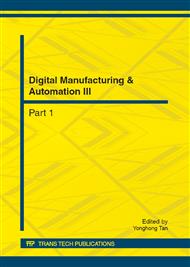p.111
p.115
p.121
p.126
p.133
p.139
p.143
p.147
p.151
Optimization of Valve Block Shape Using CFD
Abstract:
Stop valves are commonly used as fluid flow control equipments in many engineering applications. A numerical study of a three-dimensional, complex geometry, stop-check valve was performed for model validation and improved understanding of valve flow features. This paper has provided a numerical investigation of the fluid flow inside a stop valve, including the modeling and the simulation of the stop valves. According to the simulation result of original valve structure, two cone valve block shape with different gradient are presented to bring some optimization to the stop-valve. CFD simulations were conducted for different structure of the valve to verify the performance of the valve after redesign the internal flow structure. The simulation results show that the pressure drop vortex strength, maximum velocity and velocity nonuniformity of valve outlet had been reduced obviously. Furthermore, the results of the three-dimensional optimization analysis of valve shape can be used in the design of low noise and high efficiency valve for industry.
Info:
Periodical:
Pages:
133-138
Citation:
Online since:
July 2012
Authors:
Keywords:
Price:
Сopyright:
© 2012 Trans Tech Publications Ltd. All Rights Reserved
Share:
Citation:


